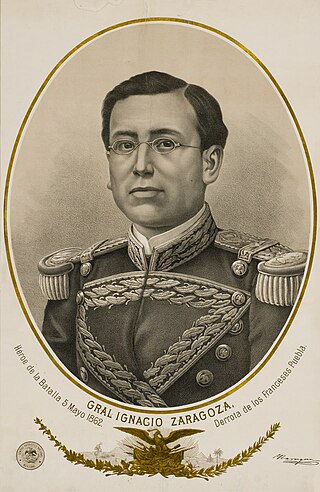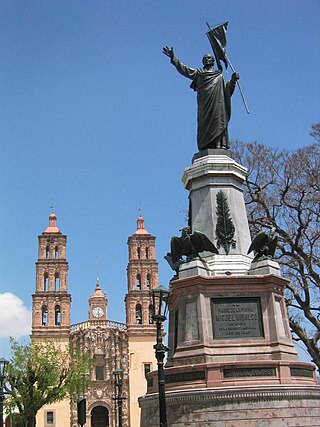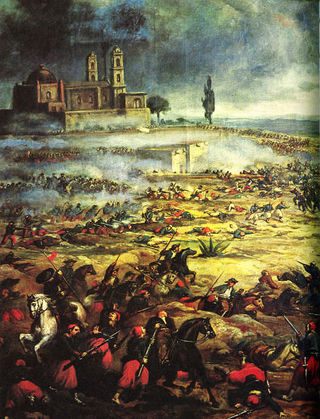This article needs additional citations for verification .(December 2009) |
Fiestas Patrias (English: Patriotic Holidays) in Mexico originated in the 19th century and are observed today as five public holidays.
This article needs additional citations for verification .(December 2009) |
Fiestas Patrias (English: Patriotic Holidays) in Mexico originated in the 19th century and are observed today as five public holidays.
This day (English: "Anniversary of the Constitution") commemorates the Constitution of 1917, promulgated after the Mexican Revolution on February 5. Article 74 of the Mexican federal labor law (Ley Federal del Trabajo) provides that the first Monday of February (regardless of the date) will be an official holiday in Mexico marking this occasion. [1] This was a modification of the law made in 2005, effective since 2006; before that, it was celebrated on February 5 regardless of the day of the week in which the date occurred.
This day (English: Birth of Benito Juárez) commemorates President Benito Juárez's birthday on March 21, 1806. Juárez is popularly regarded as Mexico's greatest president, who instituted the separation of Church and State in the La Reforma (Liberal Reform in Mexico). Juárez is recognized as a hero across the Americas for his resistance to European recolonization. [2] Article 74 of the Mexican labor law (Ley Federal del Trabajo) provides that the third Monday of March (regardless the date) will be an official holiday in Mexico. As with Constitution Day, the holiday was originally celebrated every year on the same date (March 21), but the federal labor law was modified in 2005 so the holiday is always celebrated on a Monday.
Día del Trabajo (English: Labor Day) commemorates the Mexican workers' union movements on May 1 — specifically, the 1906 Cananea, Sonora, and the 1907 Río Blanco, Veracruz, labor unrest and repression.
Labor Day in Mexico traces its origins to the 1886 Haymarket massacre in Chicago, but the first Labor Day in Mexico was when 20,000 workers marched against President Victoriano Huerta demanding fair working conditions in 1913. In 1923, President Álvaro Obregón declared May 1 the Día del Trabajo en México, but the day was officially established by Plutarco Elías Calles in 1925. [3]
Grito de Dolores (on the evening of September 15) and Aniversario de la Independencia (September 16) commemorate Father Miguel Hidalgo y Costilla's Grito de Dolores — on September 16, 1810, in the village of Dolores, near Guanajuato. Hidalgo called for the end of Spanish rule in Mexico. On October 18, 1825, the Republic of Mexico officially declared September 16 its national Independence Day (Dia de la Independencia).
Mexican Independence day, also referred to as Dieciséis de septiembre, is celebrated from the evening of September 15 with a re-creation of the Grito de Dolores by all executive office-holders (from the President of the Republic down to municipal presidents) and lasts through the night. [4]
This day commemorates the Mexican Revolution which started on November 20, 1910, when Francisco I. Madero planned an uprising against dictator Porfirio Díaz's 31-year-long iron rule. Article 74 of the Mexican labor law (Ley Federal del Trabajo) provides that the third Monday of November (regardless the date) will be an official holiday in Mexico. This was a modification of the law made in 2005, effective since 2006; before then, it was November 20 regardless of the day, and all schools gave extended holidays if the day was a Tuesday or Thursday. Although November 20 is the official day, the uprising started on different days in different parts of the country.
Contrary to common misconception in the U.S., [5] [6] [7] Cinco de mayo is not Mexico's "Independence Day", but rather commemorates the victory of Mexican Republican forces over French forces in the first Battle of Puebla on May 5, 1862. In the battle fought there the following year the French forces were the victor.
In contrast to Independence Day, described above, Cinco de mayo is observed mostly at a local level in Puebla State and is a minor Bank Holiday in the rest of Mexico. Many labor unions have negotiated to have the day off, however, since its proximity to Labor Day (May 1) often allows an extended five-day weekend or two consecutive three-day weekends. The first observance of Cinco de Mayo was in Los Angeles, California, in 1863. The observance sought to boost the spirits of American and Mexican residents during the dark days of the American Civil War and the Franco-Mexican War. Puebla would not hold its own celebrations until after the French were driven out of the city a few years later. See: Hayes-Bautista, Dr. David E. El Cinco de Mayo: An American Tradition. Berkeley, University of California Press, 2012. ISBN 978-0-520-27212-5.

Columbus Day is a national holiday in many countries of the Americas and elsewhere, and a federal holiday in the United States, which officially celebrates the anniversary of Christopher Columbus's arrival in the Americas. He went ashore at Guanahaní, an island in the Bahamas, on October 12, 1492 [OS]. On his return in 1493, he moved his coastal base of operations 70 miles east to the island of Hispaniola, what is now the Dominican Republic and established the settlement of La Isabela, the first permanent Spanish settlement in the Americas.

Ignacio Zaragoza Seguín was a Mexican Army officer and politician. He is best known for leading a Mexican army of 3,791 men which defeated a 5,730-strong force of French troops at the battle of Puebla on May 5, 1862 during the second French intervention in Mexico. The Mexican victory is celebrated annually as Cinco de Mayo.

The Battle of Puebla, also known as the Battle of May 5 took place on 5 May 1862, near Puebla de los Ángeles, during the second French intervention in Mexico. French troops under the command of Charles de Lorencez repeatedly failed to storm the forts of Loreto and Guadalupe situated on top of the hills overlooking the city of Puebla, and eventually retreated to Orizaba in order to await reinforcements. Lorencez was dismissed from his command, and French troops under Élie Frédéric Forey would eventually take the city, but the Mexican victory at Puebla against a better equipped force provided patriotic inspiration to the Mexicans.

The Cry of Dolores occurred in Dolores, Mexico, on 16 September 1810, when Roman Catholic priest Miguel Hidalgo y Costilla rang his church bell and gave the call to arms that triggered the Mexican War of Independence. The Cry of Dolores is most commonly known by the locals as "El Grito de Independencia".

In the United States, public holidays are set by federal, state, and local governments and are often observed by closing government offices or giving government employees paid time off. The federal government does not require private businesses to close or offer paid time off, as is the case for most state and local governments, so employers determine which holidays to observe.

Puerto Rico celebrates all official U.S. holidays, and other official holidays established by the Commonwealth government. Additionally, many municipalities celebrate their own Patron Saint Festivals, as well as festivals honoring cultural icons like bomba y plena, danza, salsa, hamacas (hammocks), and popular crops such as plantains and coffee.
This is a list of public holidays in Chile; about half of them are Christian holidays.

Cuautla, officially La heroica e histórica Cuautla, Morelos or H. H. Cuautla, Morelos, is a city and municipality in the Mexican state of Morelos, about 104 kilometers south of Mexico City. In the 2010 census the city population was 154,358. The municipality covers 153.651 km2 (59.325 sq mi). Cuautla is the third most populous city in the state, after Cuernavaca and Jiutepec. The city was founded on April 4, 1829. The 2020 population figures were 187,118 inhabitants for the municipality and 157,336 inhabitants for the city of Cuatula.

Dia de la Independencia or Anniversario de la Independencia, September 16, commemorates Mexico's independence from Spain and is the most important patriotic statutory holiday. Parades are held and many schools are closed.

The National Day of Spain is a national holiday held annually on 12 October. It is also traditionally and commonly referred to as the Día de la Hispanidad, commemorating Spanish legacy worldwide, especially in Hispanic America.

The National Palace is the seat of the federal executive in Mexico. Since 2018 it has also served as the official residence for the President of Mexico. It is located on Mexico City's main square, the Plaza de la Constitución. This site has been a palace for the ruling class of Mexico since the Aztec Empire, and much of the current palace's building materials are from the original one that belonged to the 16th-century leader Moctezuma II.

The national flag of Mexico is a vertical tricolor of green, white, and red with the national coat of arms charged in the center of the white stripe. While the meaning of the colors has changed over time, these three colors were adopted by Mexico following independence from Spain during the country's War of Independence, and subsequent First Mexican Empire.

Mexican Revolution Day is an official government holiday, celebrated annually in Mexico on November 20, marking the start of what became the Mexican Revolution.

In 2010, Mexico celebrated both the 200th anniversary of its Independence and 100th anniversary of its Revolution. The entire year was proclaimed by President Felipe Calderón as "Año de la Patria", or "Year of the Nation". 16 September 1810 is the day of the "Grito de Dolores" or Miguel Hidalgo's call to take up arms against the Spanish colonial government. The start of the Mexican Revolution is celebrated as being 20 November 1910, when Francisco "Pancho" Villa and Pascual Orozco led the first insurrectionist attack against the regime of Porfirio Díaz. Events and other promotions of these celebrations were designed to link of Mexico's identity and historic continuity. During a speech at the inauguration of the Casa de Allende Historic Museum, President Felipe Calderón called upon Mexico to use the upcoming anniversaries to reflect on where the country has been and to think about what kind of Mexico descendants will inherit in the future. He said the vision of the insurgents of the War of Independence was forward, not backward, so every celebration of these past events must consider the future as well.

San Salvador Huixcolotla is a town and municipality in the Mexican state of Puebla in southeastern Mexico that may be best known as the birthplace of papel picado. San Salvador is of Spanish origin and translates to "Holy Savior" and Huixcolotla is Nahuatl for "place of the curved spines".

Cinco de Mayo is an annual celebration held on May 5 to celebrate Mexico's victory over the Second French Empire at the Battle of Puebla in 1862, led by General Ignacio Zaragoza. Zaragoza died months after the battle from an illness, however, and a larger French force ultimately defeated the Mexican army at the Second Battle of Puebla and then occupied Mexico City. Following the end of the American Civil War in 1865, the United States began lending money and guns to the Mexican Liberals, pushing France and Mexican Conservatives to the edge of defeat. At the opening of the French chambers in January 1866, Napoleon III announced that he would withdraw French troops from Mexico. In reply to a French request for American neutrality, the American secretary of state William H. Seward replied that French withdrawal from Mexico should be unconditional.
Plaza México is a multi-purpose retail and cultural center in Lynwood, California. It includes multiple shops, including individual stores and an indoor swap meet; many dining options; and entertainment selections, Plaza México is a cultural space for the Mexican-American community. Plaza México incorporates the design and style of plazas all over Mexico. Plaza Mexico hosts cultural festivals and performances, such as "El Grito de la Independencia" and "Cinco de Mayo" festivities.

International Workers' Day, also known as Labour Day in some countries and often referred to as May Day, is a celebration of labourers and the working classes that is promoted by the international labour movement and occurs every year on 1 May, or the first Monday in May.
Labor Day in Spain, known there as Día del Trabajador or Primero de Mayo, was first celebrated on May 1, 1889. The way in which Spaniards celebrate Primero de Mayo has varied greatly since then, due primarily to the Francoist State, which lasted from 1936 to 1975. After 4 decades of being prohibited, in 1978 the celebration was finally re-legalized and re-instated as a national holiday, and since then every Primero de Mayo has been marked by protests and manifestations all over the country, in which social advances are celebrated and workers’ rights are revindicated.
This article lists events occurring in Mexico during 2025. The list also contains names of the incumbents at federal and state levels and cultural and entertainment activities of the year.
Contrary to popular belief, Cinco de Mayo is not the celebration of Mexico's independence day.
Lots of us have heard of the Mexican holiday Cinco de Mayo, but not everyone knows what it celebrates. It is not, as some believe, Mexico's Independence Day.
Get ready for the Fiesta! Print out our original coloring page for your Cinco de Mayo (also known as Mexican Independence Day) celebration and color the Mexican flag, a sombrero, maracas, a pinata and more!